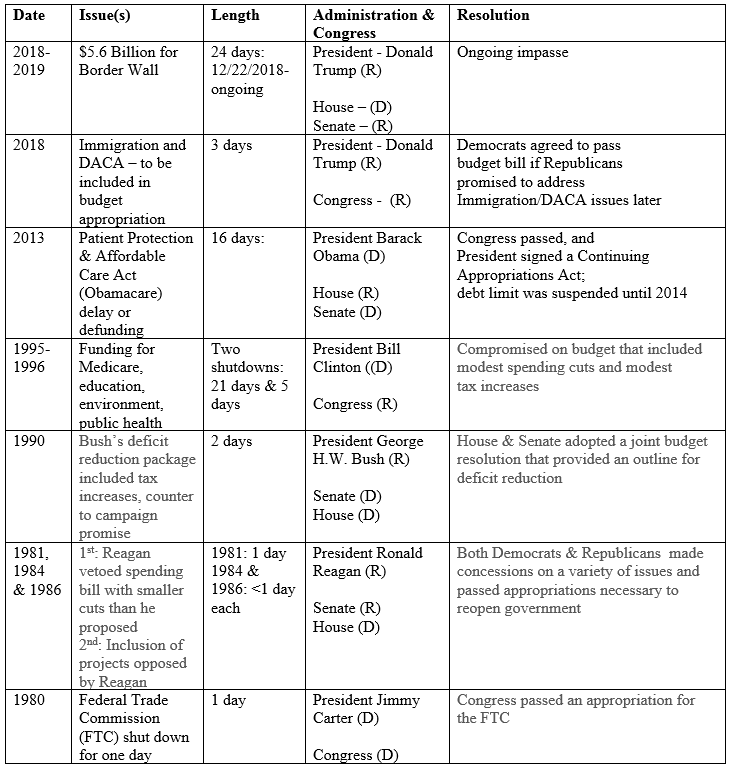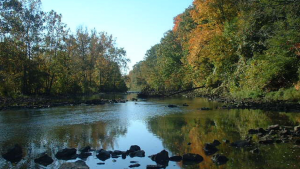As of the writing of this blog post (1/14/19) we are 24 days into the partial shutdown of our federal government. This is the longest shutdown in U.S. history. The next closest was 21 days in 1995-1996 under President Bill Clinton. I found myself wondering why shutdowns happen, what circumstances lead to them, when have they happened, and how long have they lasted. And, what impact does this have on people, communities, and the economy?
Why do shutdowns happen?
 Governmental shutdowns occur when disagreements over programs, policies, approaches, expenditures, etc. between the various elected bodies cannot be resolved. This “deadlock” can result in Congress failing to pass appropriation bills/continuing resolutions or the President refusing to sign such bills or resolutions. Since 1976 there have been 22 “gaps” in federal funding. Shutdowns can also occur at the state, territory, and local level, but this blog post will focus only on the federal government.
Governmental shutdowns occur when disagreements over programs, policies, approaches, expenditures, etc. between the various elected bodies cannot be resolved. This “deadlock” can result in Congress failing to pass appropriation bills/continuing resolutions or the President refusing to sign such bills or resolutions. Since 1976 there have been 22 “gaps” in federal funding. Shutdowns can also occur at the state, territory, and local level, but this blog post will focus only on the federal government.
A key legislative trigger of government shutdowns is the Antideficiency Act (ADA). Originally legislated by Congress in 1884, the Act has been modified a number of times since. Generally, the ADA relates to Article One of the United States Constitution (the “power of the purse“) which provides that, “No money shall be drawn from the treasury, but in consequence of appropriations made by law.” In 1980 and 1981, the then Attorney General issued two opinions that were stricter interpretations of the ADA, setting the stage for government shutdowns when funds are not sufficient or available to continue government operations, for example, or an annual appropriation has not been approved. Appropriations are “…the provision of funds, through an annual appropriations act or a permanent law, for federal agencies to make payments out of the Treasury for specified purposes.”
Shutdowns can be partial, as is the case in this current situation. That means that some government departments/agencies are able to continue to operate because their budgets have been approved already and funds have been appropriated.
So, in short, failure to reach agreement on an issue, resulting in the inability to appropriate dollars and pass a temporary or annual budget, or the president’s unwillingness to sign a budget bill or veto what is presented to him, forces “non-essential” governmental agencies and employees to cease operations or “shut down.”
What are the impacts of a government shutdown?
Impacts on Government employees and agencies
Partial government shutdowns impact employees, contractors, agency operations, public services, and the overall economy. The ADA is targeted to federal employee/federal agency actions by prohibiting the authorization or making of expenditures, incurring of financial obligations, and accepting voluntary services before a funding appropriation has been made.
Potential violations of the ADA are investigated by the government (GAO and Inspector General), and the act has consequences for both agencies and individuals who violate it. Although no one has been indicted or convicted in the Act’s 120-year history, changes in agreements and punitive administrative actions against employees have been routinely made.
In 10 of the 22 shutdowns, including this current one, government employees have been furloughed. As of last Friday, there will be no paychecks for approximately 800,000 government employees. Of that number, 380,000 employees who perform emergency work involving the health or safety of human life or protection of property – essential services and public safety fields – are still required to work but will not receive pay. This includes law enforcement, Coast Guard, corrections officers, customs/border protection, forest service firefighters, National Weather Service employees, and TSA. Receiving back pay is not automatic – Congress needs to pass authorizing legislation. Last Thursday Congress voted to approve back pay for furloughed and unpaid government workers. The President indicated that he would sign the bill. (Source: https://www.govexec.com/management/2019/01/senate-unanimously-passes-legislation-providing-back-pay-furloughed-feds/154090/)
Government Departments and Agencies Affected
Nine of fifteen cabinet–level departments and many agencies have been impacted by the current partial shutdown. Those agencies that had already received their appropriations, and are therefore unaffected, include the Defense Department and Department of Health and Human Services. Department/agencies impacted by the shutdown include Transportation, Housing and Urban Development, Agriculture, National Park Service, Homeland Security, IRS, and others.
Impact on Ohio
The impact of the shutdown is being felt by states across the U.S. to greater or lesser degrees. The number of governmental employees furloughed in impacted federal agencies (National Park Service, for example) is often a determining factor. In Ohio, the offices and visitors center of National Historic sites such as William Howard Taft and the interpretive center of the Cuyahoga Valley National Park are closed. In Cincinnati, EPA workers have been furloughed. Home buyers seeking government loans are facing delays. In rural areas, Department of Agriculture loans are not being issued. The Federal District Court and Court of Appeals in Ohio are not operating. While the grounds of National Park sites may be open, there are no government workers to pick up trash, conduct maintenance, or clean bathrooms. Some park sites that are operated by private groups remain open. It is advisable to contact each site before visiting. (Source: http://radio.wosu.org/post/how-federal-government-shutdown-affecting-ohio#stream/0)
History of Government Shutdowns since 1980
Since 1980 there have been 10 government shutdowns that have resulted in employee furloughs and disruptions in government services. They have ranged in length from less than one day (1984 & 1986) to our current shutdown of 24 days.

Final Thoughts
There have been many instances of government shutdowns over our recent history. They usually arise over disagreements in priorities and budget allocations among Republicans and Democrats and between the President and Congress (or some combination thereof). Gaps in funding occur when disagreements are not resolved before the end of an existing budget cycle. The 1980 shutdown, occurring just days after the Attorney General’s opinion regarding the ADA, was the first time a government agency stopped operations as the result of a funding gap. Since then, there have been nine more that have resulted in funding gaps forcing government employee furloughs and department/agency curtailment of operations. These events have an impact either directly or indirectly on individuals and communities throughout the U.S.
Shutdowns are unique to the U.S. form of government. Most European nations operate under a Parliamentary system in which the executive needs the continued approval of the legislature to continue in power. The failure of budget passage is attributed to the executive and usually triggers an election. In other types of presidential systems, the executive branch of the government has the power to keep the government operating even without a budget.
The ultimate length of this shutdown and the resulting impact remains to be seen. What will be especially interesting is the method by which it is resolved and the structure and conditions reached in what becomes the final compromise.
The following web sites provide further information on the 2018-2019 and other government shutdowns:
http://radio.wosu.org/post/how-federal-government-shutdown-affecting-ohio#stream/0
https://en.wikipedia.org/wiki/United_States_federal_government_shutdown_of_2018%E2%80%932019
https://en.wikipedia.org/wiki/Divided_government_in_the_United_States
https://en.wikipedia.org/wiki/Government_shutdowns_in_the_United_States#1980
https://en.wikipedia.org/wiki/Government_shutdowns_in_the_United_States
https://en.wikipedia.org/wiki/Antideficiency_Act
https://www.senate.gov/reference/glossary_term/appropriation.htm
https://www.gao.gov/legal/appropriations-law-decisions/resources
 Myra Moss, associate professor and Extension educator, OSU Extension – Community Development
Myra Moss, associate professor and Extension educator, OSU Extension – Community Development
The content of this site is published by the site owner(s) and is not a statement of advice, opinion, or information pertaining to The Ohio State University. Neither text, nor links to other websites, is reviewed or endorsed by The Ohio State University.
 Here in Central Ohio climate change is often not the first thought on my mind. After all, we aren’t experiencing the most intense impacts – drought, hurricanes, flooding coastlines, massive fires – all destroying property and, worst yet, taking lives – are we?
Here in Central Ohio climate change is often not the first thought on my mind. After all, we aren’t experiencing the most intense impacts – drought, hurricanes, flooding coastlines, massive fires – all destroying property and, worst yet, taking lives – are we? Who among us doesn’t want to live, work and play in a vibrant community? In addition to supporting local entrepreneurs, each of us can help to cultivate community vitality by understanding the larger strategies designed to assist small businesses to grow and thrive. Programs that help to develop business plans, obtain financing and market and manage enterprises are frequently included in a community’s economic “tool box.” Universities, Small Business Development Centers and local Chambers of Commerce often provide direct assistance that can range from one-on-one consultation to classroom instruction and group workshops.
Who among us doesn’t want to live, work and play in a vibrant community? In addition to supporting local entrepreneurs, each of us can help to cultivate community vitality by understanding the larger strategies designed to assist small businesses to grow and thrive. Programs that help to develop business plans, obtain financing and market and manage enterprises are frequently included in a community’s economic “tool box.” Universities, Small Business Development Centers and local Chambers of Commerce often provide direct assistance that can range from one-on-one consultation to classroom instruction and group workshops.
 Just recently launched online through the eXtension Community Planning and Zoning Community of Practice, ACP provides continuing education for paraprofessional planners and zoning officials, offering the nationally recognized credential of Master Citizen Planner.
Just recently launched online through the eXtension Community Planning and Zoning Community of Practice, ACP provides continuing education for paraprofessional planners and zoning officials, offering the nationally recognized credential of Master Citizen Planner.
 With the beginning of 2017, many of us are creating our New Year’s Resolutions. These resolutions are often focused on our individual welfare, benefiting our physical and mental well-being. So we may resolve to join the local gym to get more exercise, go to bed earlier to get 7-8 hours of sleep and commit to eat more fruit and vegetables. With these lifestyle changes, we hope to live a long and healthy life.
With the beginning of 2017, many of us are creating our New Year’s Resolutions. These resolutions are often focused on our individual welfare, benefiting our physical and mental well-being. So we may resolve to join the local gym to get more exercise, go to bed earlier to get 7-8 hours of sleep and commit to eat more fruit and vegetables. With these lifestyle changes, we hope to live a long and healthy life. Many small towns want to improve their current condition for a number of reasons. What we often hear from residents and leaders is: “We are tired of our “best and brightest” leaving the area for college and never returning because we have no jobs/careers for them,” or “Our retired residents have to seek appropriate housing in other communities because there isn’t any here,” or “The youth that remain are not “work ready” and opioid use among them has become a real problem.” Some of these towns have existing community or economic development plans that, while they might offer viable solutions, were never fully implemented (the old “the plan sits on the shelf” complaint).
Many small towns want to improve their current condition for a number of reasons. What we often hear from residents and leaders is: “We are tired of our “best and brightest” leaving the area for college and never returning because we have no jobs/careers for them,” or “Our retired residents have to seek appropriate housing in other communities because there isn’t any here,” or “The youth that remain are not “work ready” and opioid use among them has become a real problem.” Some of these towns have existing community or economic development plans that, while they might offer viable solutions, were never fully implemented (the old “the plan sits on the shelf” complaint).
 Communities and individuals across Ohio are being impacted daily by the Energy Boom – through shale horizontal drilling, related business growth, and the development of pipelines crisscrossing all parts of the state. Energy companies are approaching landowners to lease their land or purchase pipeline rights of way. Community leaders are experiencing an influx of workers and their families, impacting roads, social services, housing and schools.
Communities and individuals across Ohio are being impacted daily by the Energy Boom – through shale horizontal drilling, related business growth, and the development of pipelines crisscrossing all parts of the state. Energy companies are approaching landowners to lease their land or purchase pipeline rights of way. Community leaders are experiencing an influx of workers and their families, impacting roads, social services, housing and schools. For example, agricultural land uses in watersheds that provide source water for metropolitan areas has become a major concern as of late. While it is a city’s responsibility to provide quality drinking and recreational water resources to residents at a reasonable cost, it is the goal of agricultural producers to provide food for America’s consumers, also at a reasonable cost, while bringing in sufficient revenues needed to stay in business.
For example, agricultural land uses in watersheds that provide source water for metropolitan areas has become a major concern as of late. While it is a city’s responsibility to provide quality drinking and recreational water resources to residents at a reasonable cost, it is the goal of agricultural producers to provide food for America’s consumers, also at a reasonable cost, while bringing in sufficient revenues needed to stay in business.
